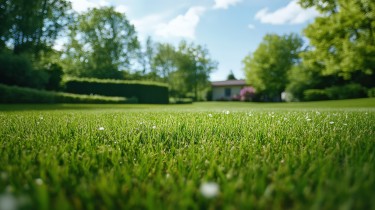

Discover the Secret to a Lush and Healthy Lawn
Read More ›
Blog
Choose the right grass for a thick, green lawn

If you’re like most people, you don’t think too much about the type of grass you have. All you want is a lawn that is thick and lush, but if the grass in your yard isn’t suited to Virginia’s unique climate, getting that carpet of green can be an extremely frustrating experience!
There are basically two types of grasses to choose from — cool-season grasses and warm-season grasses. If you live in the northern or southern states, the choice is clear… but choosing the type of grass to grow in Virginia is a bit more challenging!
Here are the pros and cons of each type.
The climate in the transition zone is in the middle between the colder zones in the north and the warmer zones in the south, which makes choosing the right grass for your lawn a bit tricky — there really isn’t a single turfgrass that is adapted to such a diverse climate. The transition zone is in the central portion of the country where temperate and subtropical climates meet.
Cool-season grasses can’t tolerate the hot summers, and warm-season grasses have trouble surviving the cold winters. So which turfgrass do you choose?

Some Virginia homeowners choose warm-season grasses, like Bermudagrass or zoysiagrass for their lawns.
Both are drought-tolerant and can withstand the cold — going dormant and turning brown in the fall. Of the two, zoysiagrass (in particular the Meyer variety) is the better choice, since Bermudagrass is quite invasive and will quickly take over your gardens.
Occasionally I find zoysia lawns in our service area, but most are a 50/50 blend of zoysia and fescue since zoysia will only thrive if it gets full afternoon sun. The fescue is needed for areas in your yard that get partial sun or are completely shaded.
On the surface, this sounds like a good compromise for lawns in the transition zone… a little bit of each, right?
But even though zoysiagrass isn’t as invasive as Bermudagrass, it’ll still outrun any fescue in your yard, leaving clumps of fescue in shaded areas. Your lawn ends up looking patchy and uneven over time.

The type of turf we recommend to our clients here in northern Virginia is tall fescue, a cool-season grass. It’s been field-tested and has been proven to germinate and resist disease and drought better than any other species in our area.
Having a lawn with a diverse mix of tall fescues (from 3–5 different varieties) make it even more resilient against drought and disease.
Other cool-season grasses include perennial ryegrass, Kentucky bluegrass and fine fescues. These grasses will all produce a decent lawn, but they’re not as heat tolerant as tall fescue and will become semi-dormant under prolonged periods of heat and drought.
Cool-season grasses are actively growing in the spring and fall, since they prefer temperatures between 50–80ºF and tend to go dormant in the heat of the summer and turn brown. This is the perfect time to lay new sod, plant grass seed and repair damaged lawns.

Dormancy is a natural part of your grass’s life cycle, but there are still some things you can do to keep your lawn green and looking like a golf course, even in the heat of the summer.
As you can see, if you want a great lawn, it’s important to grow the right variety of grass for your area and care for it properly… but we know “lawn care” may not be on your list of “fun things to do this summer”... but it is on our list!
Want some help with your lawn? Leave it to us.
We understand not everyone has the time (or desire) to care for their lawns, so the team at Brandon Rushing is always happy to help.
See our lawn care programs or get a free quote.
Written by Brandon Rushing, Founder & President
Posted on: June 22nd, 2022